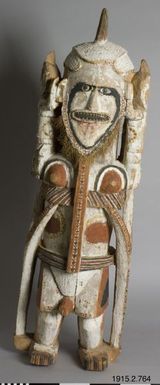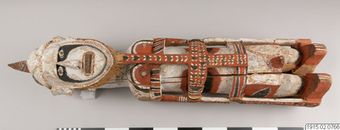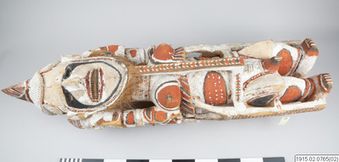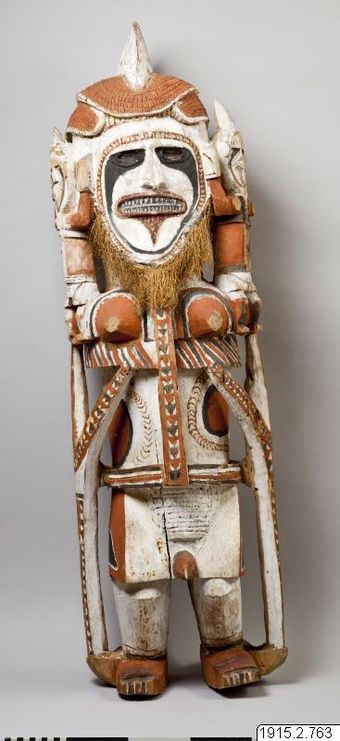skulptur, figur, sculpture, uli
- Description:
- The return of the Uli When you look at the wooden figure in the showcase, a so-called Uli from New Ireland, an island in the Bismarck Archipelago north of Papua New Guinea, you could easily get the feeling that the people who created this creature must have had extraterrestrial contacts. That is probably not the case. The figurine was part of a funeral ceremony by the same name, Uli. In the good old days this tradition, extinct since the early 20th century, was a ceremony practiced when an important leader had passed away. The figure symbolized the soul of the deceased. An Uli is an androgyne with breasts as well as penis, and a big head that symbolizes the soul, thought to be housed in the head. Every month for a period of one year or more, the village of the deceased would arrange a series of feasts to commemorate the dead person. Many pigs were slaughtered and the Uli participated. At the grand finale the neighboring villages came to the feast, all bringing their own Ulis, freshly painted for this great day. After that, the Uli was moved to a special house, owned by the “Big man” (leader) of the village. There it was put “on display” for certain selected persons to see, and to promote future spiritual support to the village and its new leader. This is not the first time that the Uli, numbered 1915.2.764, sees the day of light and is put “on display” since its long journey from New Ireland at the beginning of the last century. It was exposed in 1989, in the great exhibition about Melanesia in the Museum of Ethnography in 1989 (text from the website, object of the month, June 2007).
- Location:
- Papua New Guinea
- Format:
- image
- Collections:
- Museum of Ethnography
- Content partner:
- Museum of Ethnography
- Availability:
- Not specified
-
Copyright status: Share, modifyFind out more about what you are able to do with this itemMore informationMuseum of Ethnography has this to say about the rights status of this item:
http://creativecommons.org/publicdomain/zero/1.0/
What can I do with this item?Non-infringing useNZ copyright law does not prevent every use of a copyright work, and this item may be hosted by an international institute or organisation. You should consider what you can and cannot do with a copyright work.Share itThis item is suitable for copying and sharing with others, without further permission.Modify itThis item is suitable for modifying, remixing and building upon, without further permission.Check about commercial useYou'll need to confirm with the copyright holder using this item for commercial purposes.
Related items
Welcome and warm Pasifik greetings
The information on this site has been gathered from our content partners.
The names, terms, and labels that we present on the site may contain images or voices of deceased persons and may also reflect the bias, norms, and perspective of the period of time in which they were created. We accept that these may not be appropriate today.
If you have any concerns or questions about an item, please contact us.



